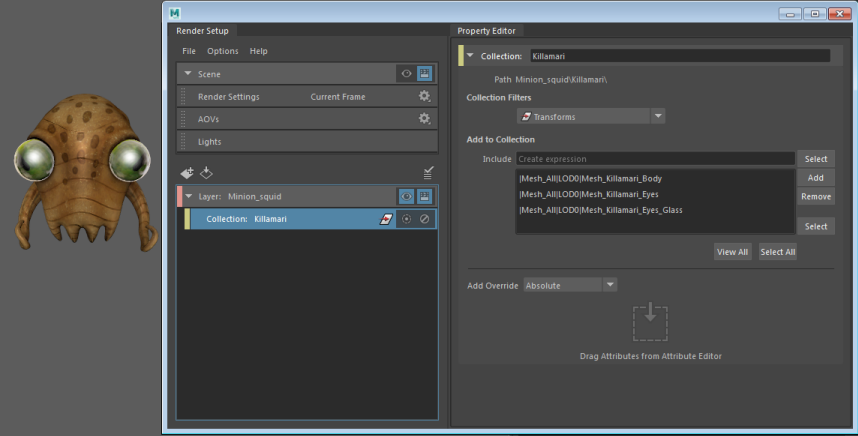Subcollections may be created automatically for you when you create an override. Maya automatically recognizes the node type that is being overridden, and creates a subcollection for that node type. Alternatively, you can also manually create a subcollection for a specific node type such as shaders, shapes or sets.
Subcollections created automatically by Maya
Layers are populated via collections. When you add objects to a collection, only their transform node is included. This determines the objects you see in the viewport when the layer is visible.
In this example, a render layer Minion_squid is populated with the collection Killamari. The Mesh_Killamari body, eyes, and eyes glass transform nodes are added to the collection, and therefore the character's body, eyes, and eyes glass are visible in the viewport.

When you create an override on an attribute on the shader; for example, Ambient Color, Maya automatically creates a collection that includes all the shaders assigned to the Mesh_Killamari nodes, as well as the corresponding override. In other words, it is not necessary to manually add the shaders of Mesh_Killamari to the Killamari collection, nor is it necessary to manually create a shaders collection.
Similarly, when you create an override on the shape node, for example, Template, Maya automatically creates a collection that includes all the corresponding shape nodes of Mesh_Killamari, as well as the corresponding override.
The type of nodes that each collection contains is denoted by an icon; for example
 for shaders, and
for shaders, and
 for shapes.
for shapes.
Subcollections are not created when an override is created on the transform node.
Subcollections are also not created when Collection Filters is set to All. This is because subcollections are only created when the current collection does not include the node type for which you want to create an override. This condition is never true when your filter is set to All.
You can Shift-click to expand a render layer or collection to display all its child collections and overrides. Shift-click again to fully collapse it. Now when you click this item again, it is expanded, but not its children.
For more information about creating overrides, see Create overrides for a collection in your render layer.

Parent collection membership versus subcollection membership
The parent collection determines the objects that belong in the layer, and a child collection (subcollection) should only contain a subset of the members of its parent collection.
For example, the following scenario is valid:
- parent collection members: window, door, table, floor
- child collection members: table and floor
The following scenario, however, is not valid:
- parent collection members: window, door and table
- child collection members: floor
In the latter case, the floor will not appear in your layer when it is set as visible.
An example use of subcollections may be to add a castle to your parent collection, then create a subcollection for only the castle door. This way, your entire castle is visible in the layer, and you can add a rotate override to the subcollection that applies only to the door. This allows for finer control over which nodes should receive overrides.
If you want to add members to a layer after a subcollection has been created, the new members should be added to the parent collection and not the child collection, for the same reason as stated above: because the parent collection determines membership, and a child collection should only contain a subset of the parent collection's members.
Create a subcollection
- Right-click a collection and select Create Collection.
- In the Collection Filters drop-down list, select the node type for your collection.
- Add nodes to your subcollection as you would to any collection; for example, via an expression, by selecting nodes and clicking Add, or a combination of both. For more information, see Add members to your collection.
Application of subcollections
Using subcollections, you can create a parent collection to control the membership of objects in your layer (and thus the objects that are rendered when the layer is rendered), then create a subcollection to apply overrides to only a subset of nodes. Some examples include:
- Create a parent collection that contains a head model, then create a subcollection of shading engines that contains the SG nodes applied to the skin of the model. Create a shader override to assign the skin to a different shader. See Use hierarchical collections to override shaders applied per face.
- Create a parent collection that contains a city, then create a subcollection that contains the lamp posts. Create a Translate override to move all the lamp posts simultaneously.